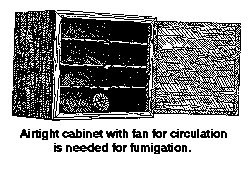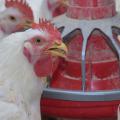Fumigation and sanitation of hatching eggs
Sanitize eggs and equipment before storage or use by fumigating. Under-fumigation does not kill the bacteria, but over- fumigation can kill the chick embryo in the egg. Use recommended amounts of chemicals at the right time for the length of time specified.
A room or cabinet large enough to hold the eggs is required. It must be relatively air tight and equipped with a small fan to circulate the gas. Calculate the inside volume of the structure by multiplying the inside length by the width by the height.
 Stack the eggs inside the room or cabinet on wire racks, in wire baskets, or on egg flats so air can circulate among the eggs. Remove eggs from the cases for good air circulation. Formaldehyde gas is produced by mixing 0.6 gram of potassium permanganate (KmnO4) with 1.2 cc of formalin (37.5 percent formaldehyde) for each cubic foot of space in the fumigating structure. Mix the ingredients in an earthenware or enamelware container with a capacity at least 10 times the total volume of the ingredients.
Stack the eggs inside the room or cabinet on wire racks, in wire baskets, or on egg flats so air can circulate among the eggs. Remove eggs from the cases for good air circulation. Formaldehyde gas is produced by mixing 0.6 gram of potassium permanganate (KmnO4) with 1.2 cc of formalin (37.5 percent formaldehyde) for each cubic foot of space in the fumigating structure. Mix the ingredients in an earthenware or enamelware container with a capacity at least 10 times the total volume of the ingredients.
Circulate the gas within the structure for 20 minutes and then expel the gas. The temperature during fumigation should be above 70o F. Allow eggs to air out for several hours before placing them in cases.
Additional information on hatching egg sanitation and fumigation can be found in Hatchery Management Guide and Care and Incubation of Hatching Eggs.
Publications
News
STARKVILLE, Miss. -- Until an avian flu vaccine for chickens or other alternative is federally approved, commercial poultry operations in the U.S.
STARKVILLE, Miss. -- If egg prices have seemed higher than ever lately, it’s because they are, and consumers can place much of the blame squarely at the feet of the ongoing bird flu outbreak.
With highly pathogenic avian influenza, or HPAI, in the environment in Mississippi, owners of backyard flocks have to take extra steps to keep their chickens healthy.
Avian influenza poses an extremely low risk to human health and none to food safety in Mississippi, but its presence poses a risk to backyard flocks and the state’s $3 billion commercial poultry industry.







